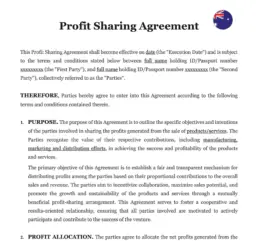Understanding the Share Profit Contract
A Share Profit Contract is a critical document that outlines how profits will be distributed among the parties involved in a business. Whether you’re in a partnership, joint venture, or any other form of business collaboration, this agreement is essential to avoid disputes and ensure that all parties are on the same page regarding profit distribution.
The Share Profit Contract specifies the percentage of profits each party is entitled to, the method of distribution, and the timing of payments. Without this agreement, misunderstandings can arise, leading to conflicts and potential legal issues.
Defining the Terms of Profit Sharing
The first step in creating a Profit Sharing Agreement is to clearly define the terms under which profits will be shared.
1. Profit Allocation: Determine the percentage of profits each party will receive. This allocation can be based on factors such as capital contributions, time invested, or specific roles within the business.
2. Profit Calculation: Establish how profits will be calculated. This could involve net profits after all expenses are paid or gross profits before certain deductions.
3. Payment Schedule: Decide on the frequency of profit distributions, whether it’s monthly, quarterly, or annually.
Clearly defining the terms of profit sharing is crucial to ensuring that all parties are satisfied with the arrangement. For more on defining contract terms, you might refer to our article on Formalizing Client Service Contracts: A Legal Guide, which discusses the importance of clear terms in service agreements.
Addressing Tax Implications
Sharing profits can have significant tax implications for both the business and the individuals involved.
1. Individual Taxation: Understand how profit distributions will be taxed at the individual level. This includes considering the tax rates applicable to different types of income, such as dividends or salary.
2. Business Taxation: Consider how profit sharing will impact the business’s overall tax liability. This might involve exploring deductions or credits that can offset the tax burden.
3. Tax Compliance: Ensure that the Share Profit Contract is structured in a way that complies with Australian tax laws. This may require consulting with a tax professional to avoid any legal pitfalls.
Incorporating Profit Sharing into Partnership Agreements
If you’re in a partnership, it’s important to integrate profit sharing into your existing Partnership Agreement.
1. Amending the Partnership Agreement: Update your Partnership Agreement to include the profit sharing terms. This ensures that all aspects of the partnership, including profit distribution, are legally binding and enforceable.
2. Profit Sharing in New Partnerships: When forming a new partnership, make sure that the Share Profit Contract is a key component of the Partnership Agreement. This prevents any ambiguity about how profits will be shared from the outset.
3. Dispute Resolution: Include a dispute resolution clause in both the Partnership Agreement and Share Profit Contract. This provides a clear process for resolving any disagreements that may arise regarding profit distribution.
Managing Profit Sharing in Joint Ventures
Joint ventures often involve multiple parties with varying levels of investment and involvement, making profit sharing particularly complex.
| ➤ Joint Venture Agreement: Integrate the Profit Sharing Agreement into the broader Joint Venture Agreement. This ensures that all aspects of the venture, including profit sharing, are covered under a single legal framework. |
| ➤ Equity-Based Profit Sharing: Consider an equity-based approach to profit sharing, where profits are distributed according to each party’s ownership stake in the joint venture. |
| ➤ Performance-Based Profit Sharing: Alternatively, you could opt for performance-based profit sharing, where profits are distributed based on each party’s contribution to the venture’s success. |











